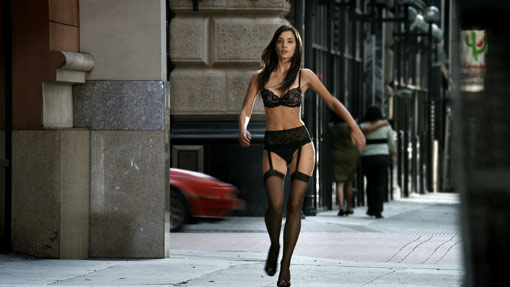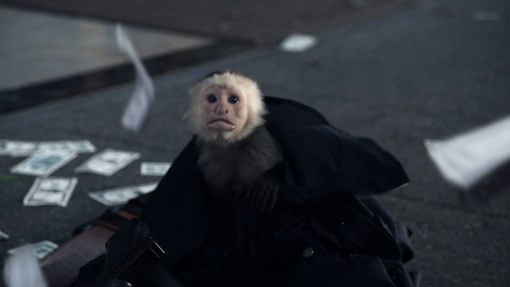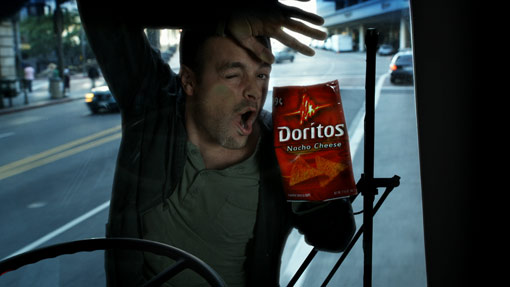How Eric Heimbold Called in Favors and Worked Fast to Get a High-Value Spot in the Can
Eric Heimbold: The toughest part was coming up with the idea. I worked for a few weeks, asking myself, “What would be the perfect Super Bowl commercial that I would like to see?” It would need a lot of laughs. And in the first few seconds you want to grab the audience as strongly as possible. I felt that going with a really massive wardrobe malfunction with a beautiful girl would be the way to go. So that was the first idea I had in my head – and then to follow it up with consecutive gags, and exit in a really powerful way, too.

Did you worry that it might be too much given the hysteria that followed the Janet Jackson thing?
It wasn’t a worry. It was a certainty. I really wanted to pursue it. The agencies have been beaten down so much by focus groups, and it’s really hard to have good, fresh ideas when everyone’s so worried about offending somebody. Me? I figured, “Well, I’m just a nobody outsider, so I can do whatever I want. I’m going to push it as far as I can.” The whole Janet Jackson controversy was so stupid. And they never owned up to it, probably because they were afraid of getting sued. I felt like you can’t not make fun of that. And it’s fun to celebrate sexuality and that dose of testosterone that we all get when we go to a football game. It was a nod to that.
I am represented for TV commercials by a production company in Venice, CA, called Wild Plum, and I did run the job through them, through their bookkeeping, to keep everything in order. But it was financed by me. I feel like it looked like a high-budget TV commercial, but we managed to shoot it in one day, and I got most people to come in and work for no money. Some people you have to pay even though they’re friends, so you have to come up with some kind of deal, and I’m enormously proud of our crew. But I managed to keep the budget down. The location fees and the money that has to go to the city of Los Angeles is higher than you’d think. They don’t give you any deals there.
Did you shoot downtown?
Yes. We shot on Seventh Street in downtown L.A. I was looking for a location that didn’t have direct sunlight falling on you at any point during the day. We didn’t have much in the way of lighting, so that allowed us to have a good ambient overall lighting, and just use one or two lamps for a little edge or keylight. We had a small generator and a couple of lamps. It would still look like a quality piece and we wouldn’t have to be fighting the sun. We found this canyon kind of street that kept the sun off of us for the whole day, and that really helped.
How did you decide on the Red camera?
We were all a little reluctant about it. At least I was. It’s more like a computer than a camera. You turn it on and you have to wait for it to boot up – so already I was like, “Oh, boy.” There’s nothing mechanical about it. It’s very small. Maybe a foot long at most. The problems with the red camera have been software related. What happens is you’re on the set and all of a sudden the camera would crash, kind of like a computer would crash. If the folks on set can’t get it to reboot, you want to go to a new camera right away, so you’d have to have a second body. But we didn’t have the money for a second body so I was a little scared about doing the job that way. But I decided to go for it. I had some assurances from a good friend of mine, Cliff Hsui, who works at SIM Video in Hollywood. He gave me the camera and some incredible [Angenieux] Optimo lenses – gorgeous, two-and-a-half-foot-long movie lenses that cost hundreds of thousands of dollars. You get a really good look. I wasn’t expecting it to look that good. But now I’m pretty certain film is on its way out.

Did you have a Red tech on hand?
Cliff came out and worked as a DIT. That was a huge help. My biggest concern was that it wouldn’t play on the Super Bowl if it didn’t look as good as or better than the other stuff that’s playing on the Super Bowl. There’s a level of quality that people respond to unconsciously. So the presentation has to be good. And the idea that I had, if I just explain it to you straight out – “Yeah, this guy bites into a chip and this girl’s clothes come flying off! And there’s a cash machine! And a cop turns into a monkey!” – it sounds really hokey. I thought the best way to take the curse off of that was to film it in a way that looked really cinematic and rich. Make it look like Three Days of the Condor.
And a lot of the energy comes out in the cutting, too. It’s a really fast-paced spot.
Yeah. A lot of the credit goes to my good friend and fantastic editor, Oliver Power at Sixty Hertz editorial [in Santa Monica]. There were two or three more gags I was trying to fit in there, but I realized I overwrote it. You can only fit a certain number of gags in 28 seconds before it starts to explode.
Talk about the VFX shots.
The tricky part was that my post supervisor was unable to come to the shoot that day because he had a paying gig. One of the main things we discussed was should I shoot these gags green screen, where you drop a stretched 15-by screen behind them, or should I just shoot them in the environment and we’ll rotoscope around it. I preferred the latter because it would make my day go faster. It takes a long time to set up and light a green screen. Without my post supervisor there I decided to just shoot everything in the environment and worry about the rotoscoping later when I didn’t have the pressure of the shoot day on top of me. And they’re all very quick events, so we’re just talking about cutting out one character or erasing wires for a few frames at a time. It wasn’t too bad. And I’m a big fan of rotoscoping because it looks more realistic. Sometimes when you shoot stuff on green screen it feels cut out, and the green or blue of the screen reflects back into the shot and it feels a little off. But you’ll never hear a post supervisor say, “Yeah, we’ll just rotoscope it!”
The woman’s dress getting ripped off – that’s just wire removal, right?
Yeah. That’s an old theatrical gag. It’s a rip-away dress, custom-made with Velcro by a costume designer I work with all the time named Marco Morante. She’s walking down the street with fishing wire attached to her, and to the long end of a fishing pole. A grip is off-screen and he yanks the pole and the clothes come flying off. We got that to work after about six takes. The poor girl. You could see the wire, so each frame was delicately painted out.
The money spewing out of the ATM – is that practical, or is that an effect?
That’s about 80 percent practical. The very last shot of the day, we focused the camera on a three-by-three-foot square of blue that happened to be painted on a wall and started throwing handfuls of money in front of that in case we needed a little extra foreground money in one of the shots. We had that as an element, so there was some composited money but most of it was practical. We rented the faà§ade of an ATM machine and built it into a set wall. At our location we found an empty storefront and set the set wall into the open doors of the storefront. Behind that, we constructed a machine that was a spinning wheel ½-inch over a chute that went toward the ATM slot. We took all this movie money and were able to jam thousands of bills in there. It’s a really good effect, blasting the money everywhere. Every homeless person in downtown L.A. came over to check that out.
When the policeman disappears, was that fishing wire, too?
Yes. The police officer stops at a mark, and at that point we cut to a police uniform in the same position that’s held up by fishing wire almost as if it were a marionette puppet, and then we just let go of the wire and it collapsed on the ground. Instead of doing a match cut, we did a morph cut between the cop and the uniform.
When the guy gets hit by the bus, did you just roto him into the shot?
What we did to make that shot look more realistic was we had some grips holding a gym mat upright and running into him to slam him from the side and give him the feeling that he got hit by something. We cut him out and then placed him in the street over a shot of the bus going by.

And then when he’s plastered against the windshield of the bus?
We weren’t driving around the street with this kid attached to a bus! We didn’t have time to get a green-screen together so we threw up a blue plastic tarp that happened to be covering a camera station because of the threat of rain that day. We said, “Hey, let’s just hold the tarp up behind him!” That was enough to cut him out. We locked the camera down inside the bus, and after we got the actor, Nic Chatfield, doing his expressions against the glass, we just drove the bus around the block to get the movement in place. Those two shots were very easily composited together.
And that was something that we all decided we needed to have. On the day of the shoot I was discussing it with some of my friends and with our cinematographer, Tony Molina, a top DP and a really good friend of mine from school. He was like, “Dude, you’ve gotta show that he’s alive.” I was like, “Can’t we show that he just got killed? Wouldn’t that be funnier?” But Tony was like, “No, if you don’t show that he’s alive they’ll never air this thing.” So at the last minute we managed to whip that shot off. And I’m really glad, because not only did we show that he’s alive, but we got another laugh at the end of the spot.
Credits:
Production Company: Wild Plum
Director: Eric Heimbold
Executive Producer: Shelby Sexton
Line Producer: Ted Robbins
Head Of Production: Sandy Haddad
DP: Tony Molina
Production Designer: Danielle Clemenza
Wardrobe: Marco Morante
Make-Up: Ashley Adams
Editorial and Post: Sixty Hertz
Editor: Oliver Power
Lead FX Artist: Dan Pierse
Colorist: Claude Shires
Producer: Suzy Ramirez
Did you enjoy this article? Sign up to receive the StudioDaily Fix eletter containing the latest stories, including news, videos, interviews, reviews and more.









Leave a Reply